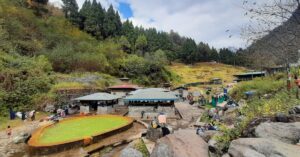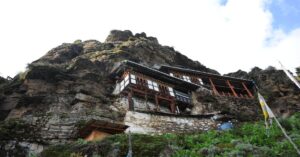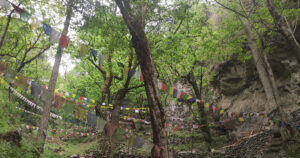Trashigang Dzong, also known as ‘The Fortress of the Auspicious Hill,’ is one of the 16 dzongs built by Zhabdrung Ngawang Namgyal in Bhutan. It was strategically built on a hilltop in Trashigang Dzongkhag in 1659.
The fortress was built to control Sharchog Khorlo Tisb Gyed (the eight regions of eastern Bhutan) and to defend against Tibetan invasions. It has played a vital role in the region’s governance, defense, and religious traditions for over 360 years.
Today, Trashigang Dzong serves as an administrative and monastic center. It also hosts the vibrant annual Trashigang Tshechu festival.
How to Reach Trashigang Dzong
Trashigang Dzong is located on a hilltop with cliffs on three sides, just below the highway, overlooking the confluence of the Drangme Chhu and the Gamri Chhu. A narrow road carved through the cliffside leads to the only entrance from the north. It is open daily from 9:00 AM to 5:00 PM.
History of Trashigang Dzong
According to the history of Trashigang Dzong, the fortress was built by Trongsa Penlop (Governor) Chogyal Minjur Tempa in 1659. Chhogyal Minjur Tempa ordered Kudung Pekar Chophel to build the fortress on the auspicious hill, following the prophecy of Zhabdrung Ngawang Namgyal.
The dzong was built to control the local chieftains of the eight eastern regions of Bhutan (Sharchog Khorlo Tisb Gyed) and guard against Tibetan invasions.
Later, Gyalsey Tenzin Rabgye expanded the dzong and added a Goenkhang between 1680 and 1694. In 1710, the second Dzongpon, Khamsum Wangdi, commissioned the writing of the Kanjur (a translation of the words of the Buddha).
Dzongpon Thinley Tobgyal, popularly known as Dopola, expanded the dzong in 1936. Dudjom Jigdral Yeshe Dorje consecrated the dzong.
Tibetan invasions and the legend of “Sky Dzong.”
After its construction, Trashigang Dzong was repeatedly attacked by Tibetan forces. According to local legend, when the Tibetans came down from Muktangkhar, a village on the other side of the Dzong, they saw the Dzong below and said, “Trashigang Dzong isn’t a Sky Dzong but a Ground Dzong.”
However, upon reaching the banks of Drangme Chhu and looking up at the sheer cliffs and towering fortress, they declared it a “Sky Dzong”. The Tibetan army fled, frightened by its strategic location.
Trashigang Dzong Renovation
Trashigang Dzong suffered severe damage following the earthquake on September 21, 2009. An emergency restoration of the Dzong and the Drametse Lhakhang was carried out through a partnership between the World Monuments Fund, the Prince Claus Fund, and the Bhutan Foundation. The project constructed retaining walls to prevent soil erosion on the steep slope, repaired the building’s timber frame and damaged stone walls, and enhanced water drainage to avoid future damage.
In 2014, the Government of India allocated Nu 190 million to renovate the dzong. A drasha (monk hostel) for monks, along with a tshokhang (dining area), was built outside the dzong for safety. The full renovations of the dzong were completed in 2019.
Description of Trashigang Fortress Dzong
Trashigang Dzong is accessible only from the north, via a narrow road that runs along the cliffside. At the entry gate, on the left, there is a Mani Lhakhang and a slate carving of Seng Dongma, a local protector who is half-male, half-female.
Trashigang Dzong houses six Lhakhangs, including a Goenkhang. The first floor of the central tower (Utse) is the Goenkhang (the inner sanctum of a guardian deity), dedicated to Mahakala. It houses statues of Goenpo Chamdrel Sum (Mahakala, Mahakali, and the Raven Crown) and Goenpo Lhengyed. It features wall paintings of a mythical yeti created by Lam Sonam Zangpo, Lam Moenlam Rabzang, and Kholong Kota. There is another shrine dedicated to the Choegi Gyelpo, the wrathful form of Avalokiteshvara.
The Lam Lhakhang is dedicated to the Eight Great Indian Masters of Buddhism, while the Tshogshing Lhakhang features lineages of the Drukpa, Karmapa, Nyingmapa, and Dzogchen Lamas. The Guru Lhakhang is a temple dedicated to Guru Rinpoche, and the Tshechu Lhakhang houses statues of Guru Rinpoche and his eight manifestations.
Tashigang Dzong also houses the rifles surrendered by Indian soldiers while returning home through Trashigang after the 1962 Sino-Indian War.
Festival of Trashigang Dzong
Trashigang Tshechu is a three-day annual religious festival held at Trashigang Dzong from the 9th to the 11th day of the 10th Bhutanese lunar month. The old Thongdrol of Guru Tshengyed (8 manifestations of Guru Rinpoche) and the Neten Chudrug (Sixteen Arhats) are displayed, along with the Guru Tshengyed dance and other traditional performances.
Best Time to Visit Trashigang Dzong
The best times to visit Trashigang Dzong are in spring (March-May) and autumn (September-November). However, the Trashigang Tshechu festival is the perfect time for an immersive cultural experience in eastern Bhutan. You can visit the major pilgrimage sites of Trashigang with the Bhutan Pilgrimage Package.
Places to explore in Trashigang
Dangling Tsho: It is the historic lake of Meme Dangling in the north of Khaling under Trashigang Dzongkhag. The lake can be reached after a 7-hour walk from Khaling town.
Chador Lhakhang: A sacred Lhakhang in eastern Bhutan that houses the thumb-size replica of the Chador (Vajrapani) Statue discovered from Yuetsho Lake in Pemagatshel.
Enjoyed reading this blog?




